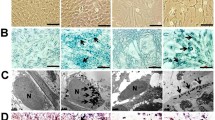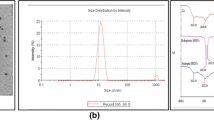Abstract
Human bone marrow-derived mesenchymal stem cells (hBM-MSCs) have been investigated as a new cell-therapeutic solution due to their capacity that could differentiate into neural-like cells. Extremely low-frequency electromagnetic fields (ELF-EMFs) therapy has emerged as a novel technique, using mechanical stimulus to differentiate hBM-MSCs and significantly enhance neuronal differentiation to affect cellular and molecular reactions. Magnetic iron oxide (Fe3O4) nanoparticles (MNPs) have recently achieved widespread use for biomedical applications and polyethylene glycol (PEG)-labeled nanoparticles are used to increase their circulation time, aqueous solubility, biocompatibility, and nonspecific cellular uptake as well as to decrease immunogenicity. Many studies have used MNP-labeled cells for differentiation, but there have been no reports of MNP-labeled neural differentiation combined with EMFs. In this study, synthesized PEG-phospholipid encapsulated magnetite (Fe3O4) nanoparticles are used on hBM-MSCs to improve their intracellular uptake. The PEGylated nanoparticles were exposed to the cells under 50 Hz of EMFs to improve neural differentiation. First, we measured cell viability and intracellular iron content in hBM-MSCs after treatment with MNPs. Analysis was conducted by RT-PCR, and immunohistological analysis using neural cell type-specific genes and antibodies after exposure to 50 Hz electromagnetic fields. These results suggest that electromagnetic fields enhance neural differentiation in hBM-MSCs incorporated with MNPs and would be an effective method for differentiating neural cells.







Similar content being viewed by others
References
Barry, F. P., & Murphy, J. M. (2004). Mesenchymal stem cells: clinical applications and biological characterization. International Journal of Biochemistry & Cell Biology, 36(4), 568–584.
Salem, H. K., & Thiemermann, C. (2010). Mesenchymal stromal cells: current understanding and clinical status. Stem Cells, 28(3), 585–596.
Izadpanah, R., Trygg, C., Patel, B., et al. (2006). Biologic properties of mesenchymal stem cells derived from bone marrow and adipose tissue. Journal of Cellular Biochemistry, 99(5), 1285–1297.
Pountos, I., & Giannoudis, P. V. (2005). Biology of mesenchymal stem cells. Injury, 36, S8–S12.
Pittenger, M. F., Mackay, A. M., Beck, S. C., et al. (1999). Multilineage potential of adult human mesenchymal stem cells. Science, 284(5411), 143–147.
Prockop, D. J. (1997). Marrow stromal cells as stem cells for nonhematopoietic tissues. Science, 276(5309), 71–74.
Woodbury, D., Schwarz, E. J., Prockop, D. J., et al. (2000). Adult rat and human bone marrow stromal cells differentiate into neurons. Journal of Neuroscience Research, 61(4), 364–370.
Sanchez-Ramos, J., Song, S., Cardozo-Pelaez, F., et al. (2000). Adult bone marrow stromal cells differentiate into neural cells in vitro. Experimental Neurology, 164(2), 247–256.
Lacy-Hulbert, A., Metcalfe, J., & Hesketh, R. (1998). Biological responses to electromagnetic fields. FASEB Journal, 12(6), 395–420.
Sun, S., Liu, Y., Lipsky, S., et al. (2007). Physical manipulation of calcium oscillations facilitates osteo differentiation of human mesenchymal stem cells. FASEB Journal, 21(7), 1472–1480.
Sert, C., Mustafa, D., Duz, M. Z., et al. (2002). The preventive effect on bone loss of 50-Hz, 1-mT electromagnetic field in ovariectomized rats. Journal of Bone and Mineral Metabolism, 20(6), 345–349.
McLeod, K. J., & Rubin, C. T. (1992). The effect of low-frequency electrical fields on osteogenesis. Journal of Bone and Joint Surgery (American), 74(6), 920–929.
Piacentini, R., Ripoli, C., Mezzogori, D., et al. (2008). Extremely low frequency electromagnetic fields promote in vitro neurogenesis via upregulation of Ca(v)1-channel activity. Journal of Cellular Physiology, 215(1), 129–139.
Cuccurazzu, B., Leone, L., Podda, M. V., et al. (2010). Exposure to extremely low-frequency (50 Hz) electromagnetic fields enhances adult hippocampal neurogenesis in C57BL/6 mice. Experimental Neurology, 226(1), 173–182.
Cho, H., Seo, Y. K., Yoon, H. H., et al. (2012). Neural stimulation on human bone marrow-derived mesenchymal stem cells by extremely low frequency electromagnetic fields. Biotechnology Progress, 28(5), 1329–1335.
Lattuada, M., & Hatton, T. A. (2007). Functionalization of monodisperse magnetic nanoparticles. Langmuir, 23(4), 2158–2168.
Pankhurst, Q. A., Connolly, J., Jones, S. K., et al. (2003). Applications of magnetic nanoparticles in biomedicine. Journal of Physics D: Applied Physics, 36, R167.
Xie, J., Xu, C., Kohler, N., et al. (2007). Controlled PEGylation of monodisperse Fe3O4 Nanoparticles for reduced non‐specific uptake by macrophage cells. Advanced Materials, 19, 2163–3166.
Greenwald, R. B., Choe, Y. H., McGuire, J., et al. (2003). Effective drug delivery by PEGylated drug conjugates. Advanced Drug Delivery Reviews, 55(2), 217–250.
Schäfer, R., Kehlbach, R., Müller, M., et al. (2009). Labeling of human mesenchymal stromal cells with superparamagnetic iron oxide leads to a decrease in migration capacity and colony formation ability. Cytotherapy, 11(1), 68–78.
Schäfer, R., Bantleon, R., Kehlbach, R., et al. (2010). Functional investigations on human mesenchymal stem cells exposed to magnetic fields and labeled with clinically approved iron nanoparticles. BMC Cell Biology, 11, 22.
Shimizu, K., Ito, A., Yoshida, T., et al. (2007). Bone tissue engineering with human mesenchymal stem cell sheets constructed using magnetite nanoparticles and magnetic force. Journal of Biomedical Materials Research Part B: Applied Biomaterials, 82(2), 471–480.
Qian, D. X., Zhang, H. T., Ma, X., et al. (2010). Comparison of the efficiencies of three neural induction protocols in human adipose stromal cells. Neurochemical Research, 35(4), 572–579.
Cho, H., Choi, Y. K., Lee, D. H., et al. (2013). Effects of magnetic nanoparticle-incorporated human bone marrow-derived mesenchymal stem cells exposed to pulsed electromagnetic fields on injured rat spinal cord. Biotechnology and Applied Biochemistry, 60(6), 596–602.
Rivers, F. J., Couillard-Despres, S., Pedre, X., et al. (2006). Mesenchymal stem cells instruct oligodendrogenic fate decision on adult neural stem cells. Stem Cells, 24(10), 2209–2219.
Bahat-Stroomza, B., Barhum, Y., Levy, Y. S., et al. (2009). Induction of adult human bone marrow mesenchymal stromal cells into functional astrocyte-like cells: potential for restorative treatment in parkinson’s disease. Journal of Molecular Neuroscience, 39(1–2), 199–210.
McCaig, C. D., Sangster, L., & Stewart, R. (2000). Neurotrophins enhance electric field-directed growth cone guidance and directed nerve branching. Developmental Dynamics, 217(3), 299–308.
Sisken, B. F., Walker, J., & Orgel, M. (1993). Prospects on clinical applications of electrical stimulation for nerve regeneration. Journal of Cellular Biochemistry, 51(4), 404–409.
McCaig, C. D. (1986). Electric fields, contact guidance and the direction of nerve growth. Journal of Embryology & Experimental Morphology, 94, 245–255.
Kunzmann, A., Andersson, B., Thurnherr, T., et al. (2011). Toxicology of engineered nanomaterials: focus on biocompatibility, biodistribution and biodegradation. Biochimica et Biophysica Acta, 1810(3), 361–373.
Zhang, Y., Kohler, N., & Zhang, M. (2002). Surface modification of superparamagnetic magnetite nanoparticles and their intracellular uptake. Biomaterials, 23(7), 1553–1561.
Riggio, C., Calatayud, M. P., Hoskins, C., et al. (2012). Poly-l-lysine-coated magnetic nanoparticles as intracellular acutators for neural guidance. International Journal of Nanomedicine, 7, 3155–3166.
Safford, K. M., Hicok, K. C., Safford, S. D., et al. (2002). Neurogenic differentiation of murine and human adipose-derived stromal cells. Biochemical and Biophysical Research Communications, 294(2), 371–379.
Mitchell, K. E., Weiss, M. L., Mitchell, B. M., et al. (2003). Matrix cells from Wharton’s jelly form neurons and glia. Stem Cells, 21(1), 50–60.
Tseng, P. Y., Chen, C. J., Sheu, C. C., et al. (2007). Comparison of the efficiencies of three neural induction protocols in human adipose stromal cells. Journal of Veterinary Medical Science, 69(2), 95–102.
Ge, D., Song, K., Guan, S., et al. (2013). Culture and differentiation of rat neural stem/progenitor cells in a three-dimensional collagen scaffold. Applied Biochemistry and Biotechnology, 170(2), 406–419.
Zhu, X. L., Eibl, O., Scheideler, L., et al. (2006). Characterization of nano hydroxyapatite/collagen surfaces and cellular behaviors. Journal of Biomedical Materials Research, Part A, 79A, 114–127.
Bock, N., Riminucci, A., Dionigi, C., et al. (2010). A novel route in bone tissue engineering: magnetic biomimetic scaffolds. Acta Biomaterialia, 6(3), 786–796.
Badaracco, M. E., Siri, M. V., & Pasquini, J. M. (2010). Oligodendrogenesis: the role of iron. Biofactors, 36(2), 98–102.
Todorich, B., Pasquini, J. M., Garcia, C. I., et al. (2009). Oligodendrocytes and myelination: the role of iron. Glia, 57(5), 467–478.
Kim, J. A., Lee, N., Kim, B. H., et al. (2011). Enhancement of neurite outgrowth in PC12 cells by iron oxide nanoparticles. Biomaterials, 32(11), 2871–2877.
Curran, J. M., Pu, F., Chen, R., et al. (2011). The use of dynamic surface chemistries to control msc isolation and function. Biomaterials, 32(21), 4753–4760.
Bito, H., & Takemoto-Kimura, S. (2003). Ca(2+)/CREB/CBP-dependent gene regulation: a shared mechanism critical in long-term synaptic plasticity and neuronal survival. Cell Calcium, 34(4–5), 425–430.
Wang, J., Weaver, I. C., Gauthier-Fisher, A., et al. (2010). CBP histone acetyltransferase activity regulates embryonic neural differentiation in the normal and Rubinstein–Taybi syndrome brain. Developmental Cell, 18(1), 114–125.
Nakagawa, S., Kim, J. E., Lee, R., et al. (2002). Regulation of neurogenesis in adult mouse hippocampus by cAMP and the cAMP response element-binding protein. Journal of Neuroscience, 22(9), 3673–3682.
Leone, L., Fusco, S., Mastrodonato, A., et al. (2014). Epigenic modulation of adult hippocampal neurogenesis by extremely low-frequency electromagnetic fields. Molecular Neurobiology, 49(3), 1472–1486.
Podda, M. V., Leone, L., Barbati, S. A., et al. (2014). Extremely low-frequency electromagnetic fields enhance the survival of newborn neurons in the mouse hippocampus. European Journal of Neuroscience, 39(6), 893–903.
Park, J. E., Seo, Y. K., Yoon, H. H., et al. (2013). Electromagnetic fields induce neural differentiation of human bone marrow derived mesenchymal stem cells via ROS mediated EGRF activation. Neurochemistry International, 62(4), 418–424.
Acknowledgments
This research was supported by the Pioneer Research Center Program through the National Research Foundation of Korea funded by the Ministry of Science, ICT & Future Planning (grant number 2009-0082941).
Author information
Authors and Affiliations
Corresponding author
Rights and permissions
About this article
Cite this article
Choi, YK., Lee, D.H., Seo, YK. et al. Stimulation of Neural Differentiation in Human Bone Marrow Mesenchymal Stem Cells by Extremely Low-Frequency Electromagnetic Fields Incorporated with MNPs. Appl Biochem Biotechnol 174, 1233–1245 (2014). https://doi.org/10.1007/s12010-014-1091-z
Received:
Accepted:
Published:
Issue Date:
DOI: https://doi.org/10.1007/s12010-014-1091-z




